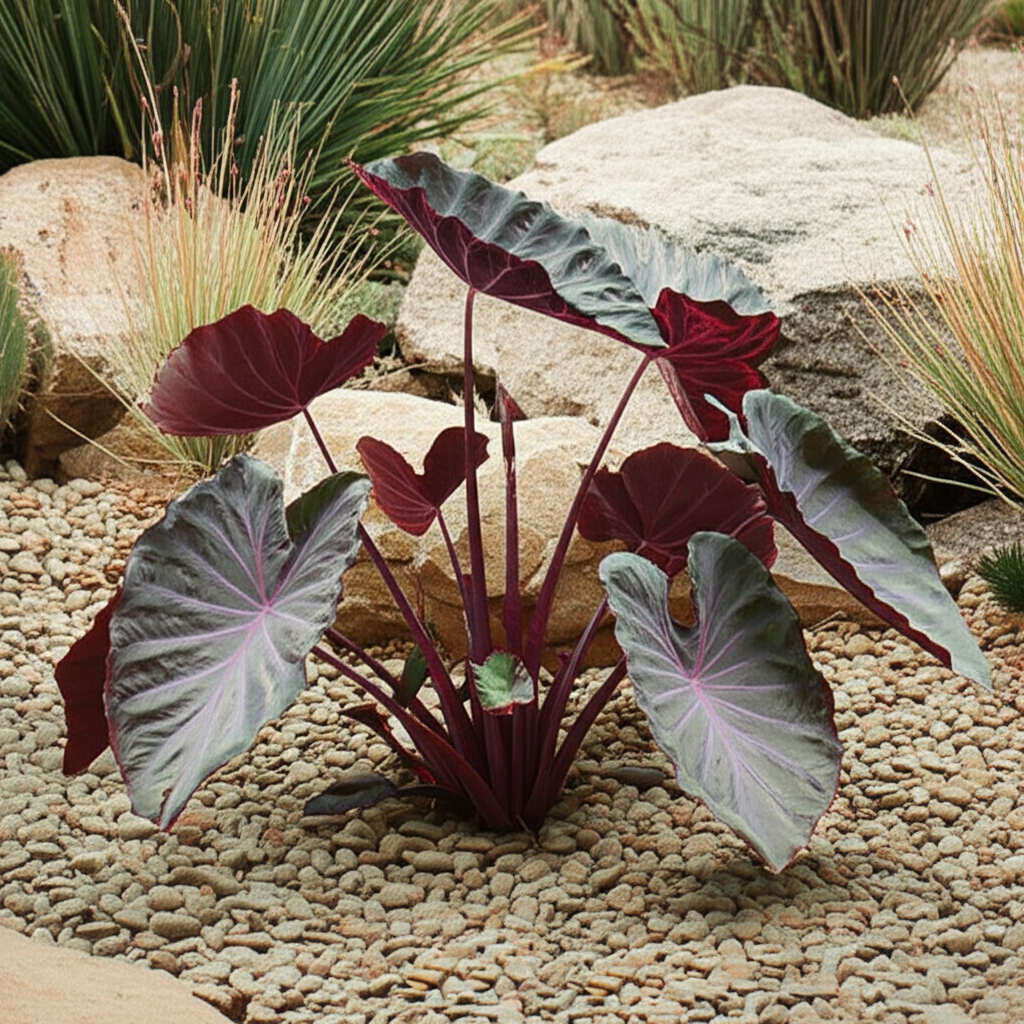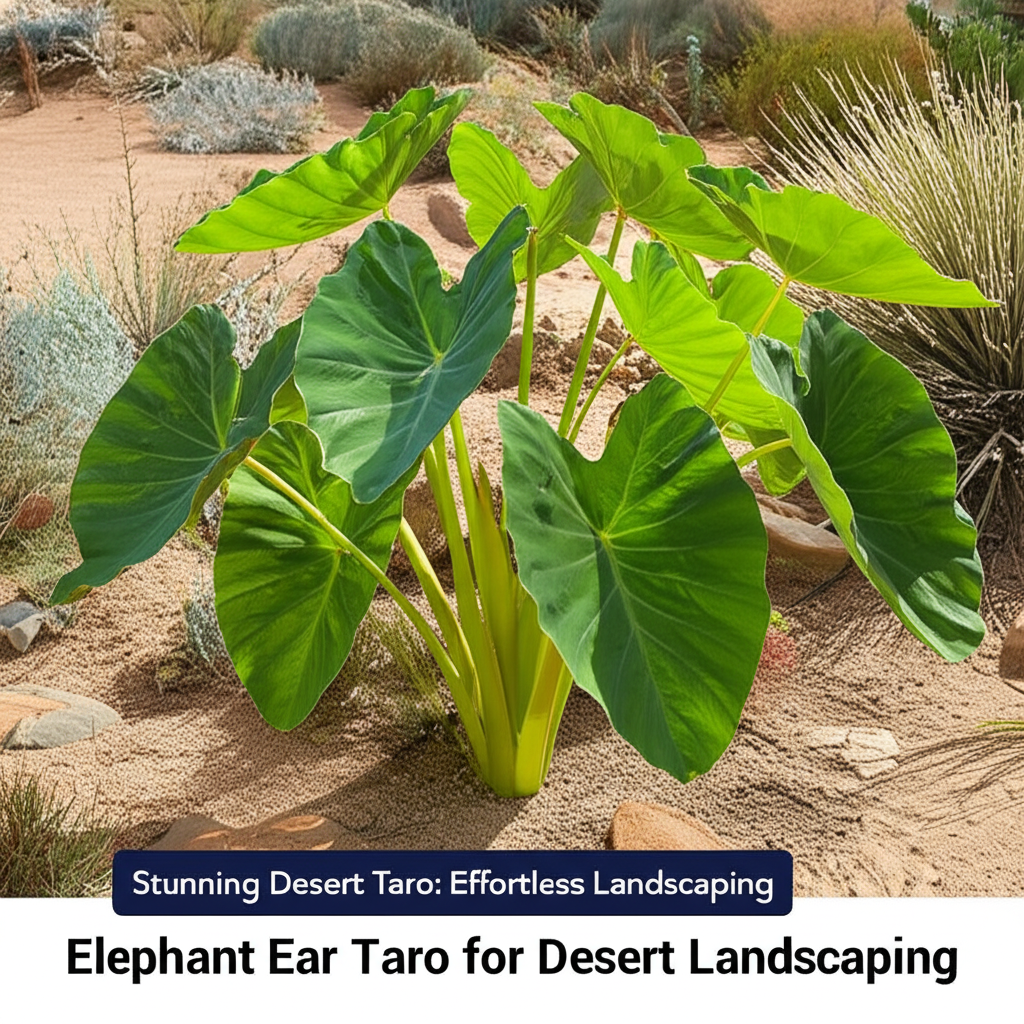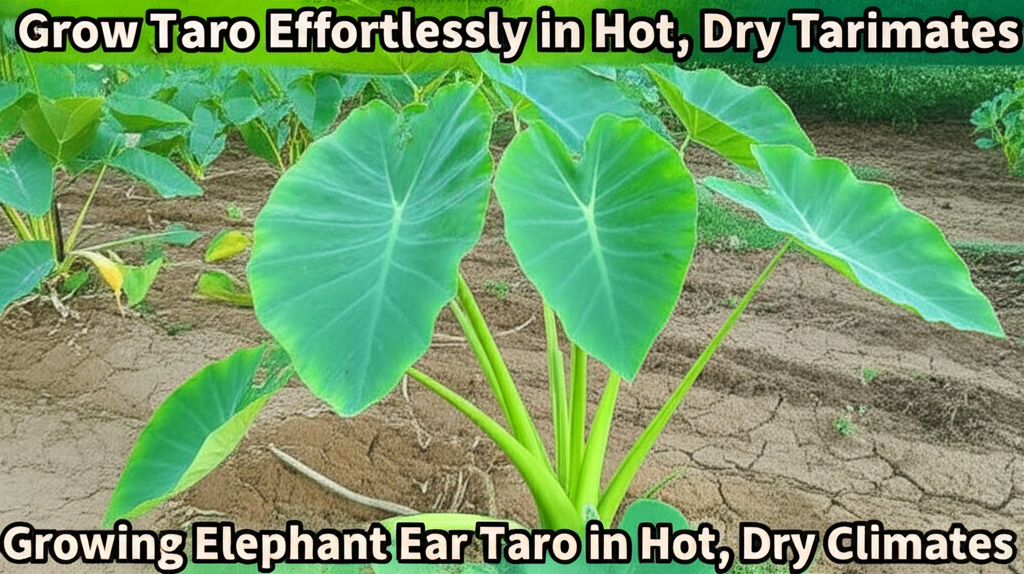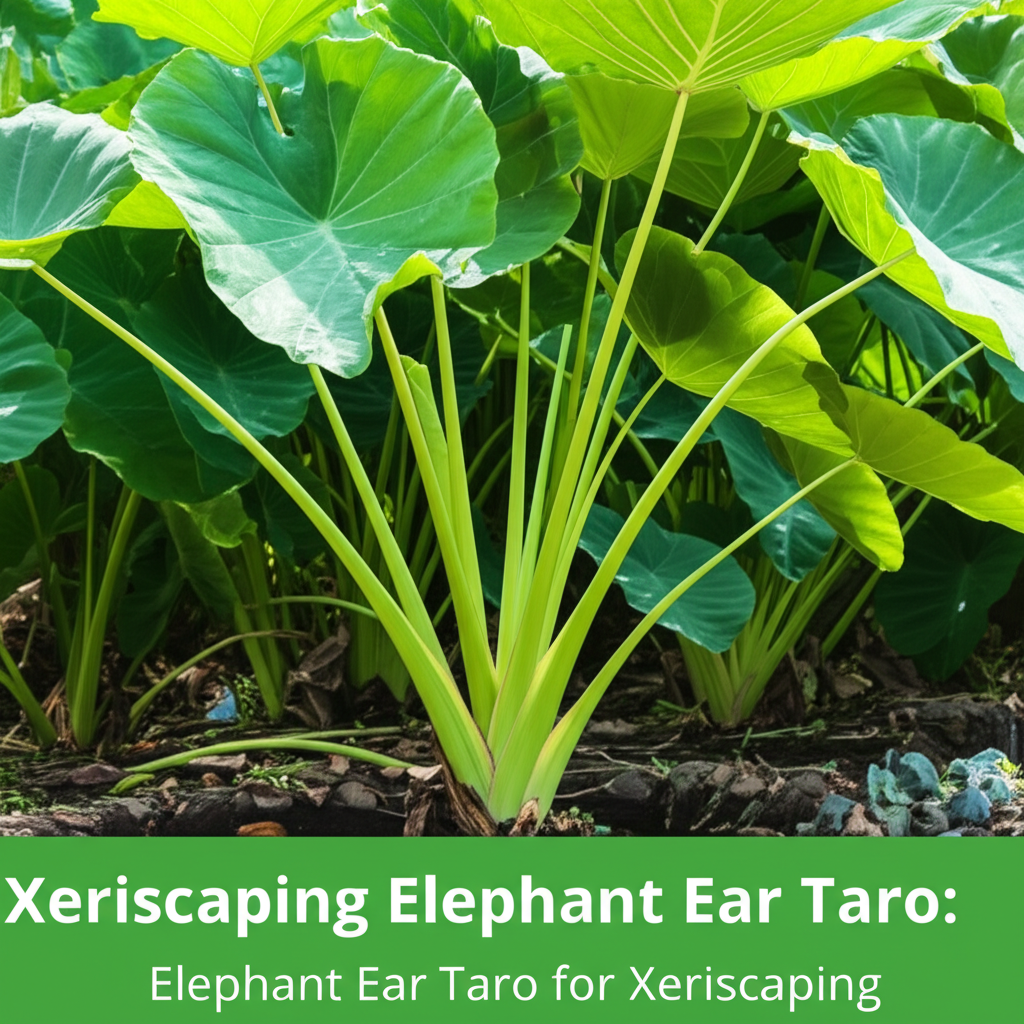Elephant Ear Taro for Desert Landscaping: Can This Tropical Beauty Thrive in Arid Climates?

The allure of lush, tropical foliage often feels out of reach for desert gardeners. We admire the dramatic, oversized leaves of plants like Elephant Ear (Colocasia esculenta) in magazines and horticultural shows, only to dismiss them as too thirsty or sensitive for our arid conditions. But what if there was a way to bring that unmistakable tropical flair to your desert oasis? Can Elephant Ear Taro truly be a star player in desert landscaping, offering effortless beauty and striking visual impact without an unsustainable water bill? Understanding the nuances of this plant’s needs in a desert environment is key to unlocking its potential and creating a truly unique, drought-tolerant paradise.
Quick Answer Box
Yes, Elephant Ear Taro (Colocasia esculenta) can be successfully incorporated into desert landscaping, but it requires careful selection of varieties, strategic planting, and efficient watering techniques. By choosing heat-tolerant cultivars and providing them with dappled shade and consistently moist, well-draining soil, you can enjoy their dramatic tropical presence without excessive water usage.
What is Elephant Ear Taro and Why It’s Important in Gardening
Elephant Ear Taro, scientifically known as Colocasia esculenta, is a perennial tuberous plant belonging to the Araceae family. It’s renowned for its exceptionally large, arrowhead-shaped leaves that can reach impressive sizes, often resembling the ears of an elephant – hence its common name. These striking leaves emerge from thick, upright stems, creating a bold, architectural statement in any garden.
The importance of Elephant Ear Taro in gardening, especially in challenging climates like deserts, lies in its ability to inject a sense of the exotic and the lush. It offers a dramatic contrast to the typically muted tones and textures of desert flora, providing a vibrant green focal point that can transform a landscape from arid and sparse to verdant and inviting. Its large leaves create a sense of abundance and can be used to soften hardscaping elements, provide shade, and even create microclimates within the garden. For desert dwellers, the opportunity to cultivate such a visually impactful plant, which is traditionally associated with more humid environments, represents a triumph of horticultural ingenuity and a chance to expand their gardening palette.
Quick Recommendations or Key Insights about Elephant Ear Taro for Desert Landscaping
Choose the Right Variety: Not all Elephant Ears are created equal. Look for cultivars known for heat tolerance and slightly lower water needs.
Location is Key: Plant in dappled shade or morning sun to protect leaves from intense afternoon sun, which can scorch them.
Soil Matters: Use well-draining soil enriched with organic matter to retain moisture without becoming waterlogged.
Water Wisely: Consistent moisture is crucial, but avoid overwatering. Drip irrigation or soaker hoses are ideal.
Mulch Generously: A thick layer of mulch helps conserve soil moisture and regulate root temperature.
Container Gardening: Pots offer excellent control over soil and moisture, making them a great option for desert Elephant Ear cultivation.
Dormancy: Understand that Elephant Ear may go dormant during extreme heat or cold, but will likely return with proper care.
Detailed Breakdown of Elephant Ear Taro for Desert Landscaping
Can Elephant Ear Taro Thrive in Desert Climates?
The direct answer is yes, with significant caveats and a strategic approach. Elephant Ear Taro, in its native tropical and subtropical habitats, thrives in consistently moist, boggy conditions. This reputation for high water needs can be intimidating for desert gardeners who are accustomed to conserving every drop. However, the key to success lies not in replicating a tropical swamp, but in understanding and meeting the plant’s fundamental requirements in an arid context.
The Scientific Perspective (Botany and Plant Biology):
Water Uptake: Colocasia esculenta is a heavy feeder and, consequently, a heavy drinker. Its large leaves have a high surface area, leading to significant transpiration (water loss). In its natural habitat, this is balanced by ample water. In the desert, this transpiration rate can quickly dehydrate the plant if not managed.Temperature Tolerance: While Elephant Ears prefer warm temperatures, extreme desert heat, especially when coupled with low humidity and intense direct sun, can be detrimental. The leaves can scorch and wilt, and the rhizomes (the underground storage organs) can overheat.
Rhizome Survival: The rhizomes are crucial for the plant’s survival and regrowth. In desert conditions, preventing these from drying out or overheating is paramount, especially during dormancy or periods of extreme stress.
Photosynthesis: Like all plants, Elephant Ear relies on photosynthesis. However, the intense desert sun can overwhelm its photosynthetic mechanisms, leading to damage rather than growth. Dappled shade allows the plant to photosynthesize efficiently without the damaging effects of direct, prolonged solar radiation.
Practical Applications in Desert Gardening:
Microclimate Creation: Planting Elephant Ears in areas that naturally receive some shade – such as the east side of a building, under a patio cover, or amongst taller, established desert-appropriate plants – creates a beneficial microclimate.Container Power: Growing Elephant Ear in large pots allows for precise control over soil composition and watering. Pots can be moved to follow the best light conditions throughout the day and season.
Strategic Watering Systems: Drip irrigation or soaker hoses placed directly at the base of the plant ensure that water reaches the root zone efficiently, minimizing evaporation. Morning watering is generally preferred in deserts to allow foliage to dry before nightfall, reducing the risk of fungal diseases.
Mulch is Your Friend: A generous layer of organic mulch (wood chips, shredded bark) around the base of the plant is essential. It acts as an insulator, keeping the soil cooler in summer and retaining moisture.
Common Myths about Elephant Ear in Deserts:
Myth 1: They are impossible to grow in the desert. This is false. With the right approach, they can not only survive but thrive.Myth 2: They require constant flooding. While they like moisture, they don’t need to be waterlogged. Overwatering can lead to root rot, especially in poorly draining desert soils.
Myth 3: Any Elephant Ear variety will do. This is a common pitfall. Some varieties are far more tolerant of heat and less water than others.
What is Elephant Ear Taro and Why It’s Important in Gardening
Elephant Ear Taro, scientifically known as Colocasia esculenta, is a perennial tuberous plant belonging to the Araceae family. It’s renowned for its exceptionally large, arrowhead-shaped leaves that can reach impressive sizes, often resembling the ears of an elephant – hence its common name. These striking leaves emerge from thick, upright stems, creating a bold, architectural statement in any garden.
The importance of Elephant Ear Taro in gardening, especially in challenging climates like deserts, lies in its ability to inject a sense of the exotic and the lush. It offers a dramatic contrast to the typically muted tones and textures of desert flora, providing a vibrant green focal point that can transform a landscape from arid and sparse to verdant and inviting. Its large leaves create a sense of abundance and can be used to soften hardscaping elements, provide shade, and even create microclimates within the garden. For desert dwellers, the opportunity to cultivate such a visually impactful plant, which is traditionally associated with more humid environments, represents a triumph of horticultural ingenuity and a chance to expand their gardening palette.
Quick Recommendations or Key Insights about Elephant Ear Taro for Desert Landscaping
Choose the Right Variety: Not all Elephant Ears are created equal. Look for cultivars known for heat tolerance and slightly lower water needs.
Location is Key: Plant in dappled shade or morning sun to protect leaves from intense afternoon sun, which can scorch them.
Soil Matters: Use well-draining soil enriched with organic matter to retain moisture without becoming waterlogged.
Water Wisely: Consistent moisture is crucial, but avoid overwatering. Drip irrigation or soaker hoses are ideal.
Mulch Generously: A thick layer of mulch helps conserve soil moisture and regulate root temperature.
Container Gardening: Pots offer excellent control over soil and moisture, making them a great option for desert Elephant Ear cultivation.
Dormancy: Understand that Elephant Ear may go dormant during extreme heat or cold, but will likely return with proper care.
Detailed Breakdown of Elephant Ear Taro for Desert Landscaping
Can Elephant Ear Taro Thrive in Desert Climates?
The direct answer is yes, with significant caveats and a strategic approach. Elephant Ear Taro, in its native tropical and subtropical habitats, thrives in consistently moist, boggy conditions. This reputation for high water needs can be intimidating for desert gardeners who are accustomed to conserving every drop. However, the key to success lies not in replicating a tropical swamp, but in understanding and meeting the plant’s fundamental requirements in an arid context.
The Scientific Perspective (Botany and Plant Biology):
Water Uptake: Colocasia esculenta is a heavy feeder and, consequently, a heavy drinker. Its large leaves have a high surface area, leading to significant transpiration (water loss). In its natural habitat, this is balanced by ample water. In the desert, this transpiration rate can quickly dehydrate the plant if not managed.
Temperature Tolerance: While Elephant Ears prefer warm temperatures, extreme desert heat, especially when coupled with low humidity and intense direct sun, can be detrimental. The leaves can scorch and wilt, and the rhizomes (the underground storage organs) can overheat.
Rhizome Survival: The rhizomes are crucial for the plant’s survival and regrowth. In desert conditions, preventing these from drying out or overheating is paramount, especially during dormancy or periods of extreme stress.
Photosynthesis: Like all plants, Elephant Ear relies on photosynthesis. However, the intense desert sun can overwhelm its photosynthetic mechanisms, leading to damage rather than growth. Dappled shade allows the plant to photosynthesize efficiently without the damaging effects of direct, prolonged solar radiation.
Practical Applications in Desert Gardening:
Microclimate Creation: Planting Elephant Ears in areas that naturally receive some shade – such as the east side of a building, under a patio cover, or amongst taller, established desert-appropriate plants – creates a beneficial microclimate.Container Power: Growing Elephant Ear in large pots allows for precise control over soil composition and watering. Pots can be moved to follow the best light conditions throughout the day and season.
Strategic Watering Systems: Drip irrigation or soaker hoses placed directly at the base of the plant ensure that water reaches the root zone efficiently, minimizing evaporation. Morning watering is generally preferred in deserts to allow foliage to dry before nightfall, reducing the risk of fungal diseases.
Mulch is Your Friend: A generous layer of organic mulch (wood chips, shredded bark) around the base of the plant is essential. It acts as an insulator, keeping the soil cooler in summer and retaining moisture.
Common Myths about Elephant Ear in Deserts:
Myth 1: They are impossible to grow in the desert. This is false. With the right approach, they can not only survive but thrive.Myth 2: They require constant flooding. While they like moisture, they don’t need to be waterlogged. Overwatering can lead to root rot, especially in poorly draining desert soils.
Myth 3: Any Elephant Ear variety will do. This is a common pitfall. Some varieties are far more tolerant of heat and less water than others.
How to Select the Right Elephant Ear Taro Varieties for Desert Landscapes
The success of your Elephant Ear planting in a desert climate hinges significantly on choosing the right cultivars. While the species Colocasia esculenta is the most common, many cultivars offer varying degrees of heat tolerance, drought resistance, and aesthetic appeal.
Key Factors to Consider When Choosing a Variety:
Heat Tolerance: Look for varieties specifically bred or noted for their ability to withstand higher temperatures without severe leaf scorch. Some cultivars are naturally more robust.
Drought Tolerance (Relative): While no Elephant Ear is truly drought-tolerant in the way a cactus is, some cultivars can bounce back more readily from short periods of dryness than others.
Leaf Color and Size: Desert landscapes can benefit from the dramatic impact of large, dark leaves (like ‘Black Magic’ or ‘Black Coral’) or striking variegated patterns. Consider how the color will complement other desert plants.
Growth Habit: Some varieties grow more upright, while others have a more spreading habit. This can influence where you plant them and how much space they require.
Availability: Depending on your region, certain cultivars may be more readily available than others. Local nurseries or specialized online retailers are good resources.
Recommended Cultivars for Desert Conditions (with caveats):
Colocasia esculenta ‘Black Magic’ (or ‘Black Coral’): These dark-leaved varieties are popular for their dramatic appearance. They tend to be somewhat more heat-tolerant than their green counterparts, but still require protection from the harshest sun. Their dark pigment can absorb more heat, so careful watering and mulching are crucial.
Colocasia esculenta ‘Mojito’: Known for its speckled, multi-colored leaves, ‘Mojito’ can also be a good choice. Its unique foliage adds visual interest.
Colocasia esculenta ‘Maui Gold’: This variety features vibrant yellow-green leaves and can handle more sun than some darker varieties. Its upright growth habit makes it a striking vertical accent.
Alocasia macrorrhiza ‘California’: While not technically Colocasia, some gardeners use the common name “Elephant Ear” for Alocasia species too. Alocasia macrorrhiza is known for its upright growth and can tolerate slightly drier conditions than many Colocasias. However, it still needs consistent moisture and shade.
Where to Find Information:
Local Nurseries: Speak with staff at reputable nurseries in your area. They often have insights into which plants perform best in your specific climate.Horticultural Societies: Local gardening groups or societies can be excellent sources of information and recommendations.
Online Retailers: When purchasing online, read descriptions carefully and look for reviews from gardeners in similar climates.
How to Plant Elephant Ear Taro in the Desert
Planting Elephant Ear Taro correctly is the foundation for its success in an arid environment. The goal is to provide an environment that mimics its preferred conditions as closely as possible, while accounting for the inherent challenges of desert heat and dryness.
Step-by-Step Planting Guide:
1. Timing is Crucial: The best time to plant Elephant Ear rhizomes or starts in most desert climates is in the spring, after the last frost and when soil temperatures begin to warm up consistently. This allows the plant to establish before the peak of summer heat.
2. Choose the Right Location:
Shade is Paramount: Select a spot that receives dappled shade or morning sun only. Avoid locations with intense, direct afternoon sun, which will scorch the leaves. An east-facing exposure is often ideal.
Protection from Wind: Strong desert winds can dehydrate plants quickly and damage their large leaves. Planting near a wall, fence, or larger shrubs can offer some protection.
3. Prepare the Soil:
Enrichment: Desert soils are often sandy and drain very quickly, which can be a double-edged sword. While good drainage prevents root rot, it also means water passes through too rapidly. Amend the planting hole generously with organic compost and aged manure. This improves moisture retention and provides essential nutrients. Aim for a mix that is rich, but still drains well.
Container Preparation: If planting in a pot, use a high-quality potting mix amended with compost and perlite or coarse sand for drainage. Ensure the pot has adequate drainage holes. Choose a pot that is at least 12-18 inches in diameter to accommodate the rhizome’s growth.
4. Planting the Rhizome:
Orientation: Elephant Ear rhizomes are typically round and somewhat flattened. Look for the “eyes” or growth buds – these should point upwards.
Depth: Plant the rhizome about 4-6 inches deep. The top of the rhizome should be covered with 4-6 inches of soil.
Spacing: If planting multiple Elephant Ears, space them at least 3-4 feet apart, depending on the mature size of the cultivar, to allow for good air circulation and prevent overcrowding.
5. Initial Watering:
Thorough Soak: After planting, water the area thoroughly. This settles the soil around the rhizome and provides the initial moisture needed for sprouting.
Keep Consistently Moist (Initially): For the first few weeks after planting, keep the soil consistently moist but not waterlogged. This encourages root development.
6. Mulching:
Apply Mulch: Once the plant shows signs of growth (new leaves emerging), apply a thick layer (2-3 inches) of organic mulch around the base of the plant, keeping it a few inches away from the actual stem. This is critical for conserving moisture, keeping the soil cool, and suppressing weeds.
Real-Life Example:
Imagine planting a ‘Black Magic’ Elephant Ear in a raised bed on the east side of your home. You’ve amended the native soil with a generous amount of compost and aged bark. You plant the rhizome 5 inches deep, water it in, and then apply a 3-inch layer of shredded redwood bark mulch. As the weather warms, you monitor the soil moisture, watering deeply every few days using a soaker hose, ensuring the soil stays consistently moist but not soggy. By mid-spring, you’ll see those iconic dark leaves unfurling, providing a dramatic tropical accent to your desert garden.
What is Elephant Ear Taro and Why It’s Important in Gardening
Elephant Ear Taro, scientifically known as Colocasia esculenta, is a perennial tuberous plant belonging to the Araceae family. It’s renowned for its exceptionally large, arrowhead-shaped leaves that can reach impressive sizes, often resembling the ears of an elephant – hence its common name. These striking leaves emerge from thick, upright stems, creating a bold, architectural statement in any garden.
The importance of Elephant Ear Taro in gardening, especially in challenging climates like deserts, lies in its ability to inject a sense of the exotic and the lush. It


